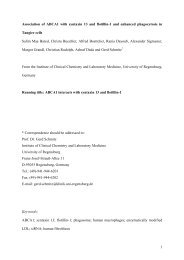SUNDAY, DECEMBER 4- Late Abstracts 1 - Molecular Biology of the ...
SUNDAY, DECEMBER 4- Late Abstracts 1 - Molecular Biology of the ...
SUNDAY, DECEMBER 4- Late Abstracts 1 - Molecular Biology of the ...
You also want an ePaper? Increase the reach of your titles
YUMPU automatically turns print PDFs into web optimized ePapers that Google loves.
<strong>SUNDAY</strong><br />
2017<br />
Samp1 is functionally associated with <strong>the</strong> LINC complex and A-type lamina networks.<br />
S. Gudise 1 , R. Figueroa 2 , V. Larsson 3 , E. Hallberg 3 ; 1 Department <strong>of</strong> Biosciences and Nutrition,<br />
Karolinska Institute, Sweden, 2 Department <strong>of</strong> Biochemistry and Biophysics, Stockholm<br />
University, 3 Department <strong>of</strong> Neurochemistry, Stockholm University, Stockholm, Sweden<br />
The transmembrane inner nuclear membrane (INM) protein Samp1 is required for anchoring<br />
centrosomes near <strong>the</strong> nuclei. Using highresolution<br />
fluorescence microscopy we show that Samp1 is distributed in a distinct and characteristic<br />
pattern in <strong>the</strong> nuclear envelope (NE), where it partially colocalizes with <strong>the</strong> LINC complex<br />
protein Sun1. By studying <strong>the</strong> localization <strong>of</strong> Samp1 deletion mutants and fusion proteins, we<br />
conclude that <strong>the</strong> cysteine-rich N-terminal half <strong>of</strong> Samp1 is nucleoplasmically exposed and is<br />
responsible for targeting to <strong>the</strong> INM. It contains four conserved CxxC motifs with <strong>the</strong> potential to<br />
form zinc fingers. The distribution <strong>of</strong> cysteine-toalanine substitution mutants, designed to<br />
prevent zinc finger formation, showed that NE localization <strong>of</strong> Samp1 depends on intact CxxC<br />
motifs. Overexpression <strong>of</strong> Samp1 zinc finger mutants produced an abnormal dominant<br />
phenotype characterized by disrupted organization<br />
<strong>of</strong> a selective subset NE proteins, including emerin, Sun1, endogenous Samp1 and, in some<br />
cases, lamin A/C, but not lamin B, Sun2<br />
or nucleoporins. Silencing <strong>of</strong> Samp1 expression showed that emerin depends on Samp1 for its<br />
correct localization in <strong>the</strong> NE. Our results demonstrate that Samp1 is functionally associated<br />
with <strong>the</strong> LINC complex protein Sun1 and proteins <strong>of</strong> <strong>the</strong> A-type lamina network.<br />
2018<br />
NE localization <strong>of</strong> <strong>the</strong> LINC complex requires multiple elements <strong>of</strong> SUN and KASH<br />
proteins.<br />
Y. G. Turgay 1 , R. Ungricht 2 , A. Rothballer 2 , A. Kiss 2 , G. Csucs 2 , P. Horvath 2 , U. Kutay 2 ; 1 Institute<br />
<strong>of</strong> Biochemistry, ETH Zurich, Zurich, Switzerland, 2 ETH Zurich, Zurich, Switzerland<br />
Inner nuclear membrane (INM) proteins are co-translationally inserted into <strong>the</strong> endoplasmic<br />
reticulum membrane (ER) and need to cross <strong>the</strong> nuclear pore complex (NPC) to reach <strong>the</strong>ir final<br />
destination. Originally, targeting <strong>of</strong> INM proteins to <strong>the</strong> INM was solely explained by a “diffusionretention”<br />
model. However, recent studies on yeast INM proteins revealed <strong>the</strong> existence <strong>of</strong><br />
classical nuclear localization signals (cNLS) that mediate <strong>the</strong> active transport <strong>of</strong> <strong>the</strong> proteins<br />
across <strong>the</strong> NPC. Whe<strong>the</strong>r active transport mechanisms also play a role in <strong>the</strong> targeting <strong>of</strong> INM<br />
proteins in mammalian cells is still unclear. We have used human SUN2 to study INM targeting<br />
and identified three different elements, which collectively mediate NE targeting. The N-terminal<br />
nucleoplasmic domain <strong>of</strong> SUN2 comprises a cNLS and a Golgi retrieval signal. The cNLS was<br />
shown to constitute a functional binding site for <strong>the</strong> heterodimeric transport receptor importin<br />
α/β. A nearby arginine cluster was found to serve as binding platform for <strong>the</strong> coatomer complex,<br />
which mediates retrieval <strong>of</strong> SUN2 from <strong>the</strong> Golgi to <strong>the</strong> ER and ensures efficient INM targeting.<br />
The conserved SUN domain at <strong>the</strong> C terminus represents <strong>the</strong> third targeting element we have<br />
identified in our study. Toge<strong>the</strong>r, our study shows that multiple elements in SUN2 contribute to<br />
NE targeting and that <strong>the</strong>se elements are not limited to cytoplasmic or transmembrane domains.
















